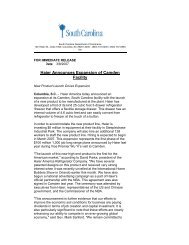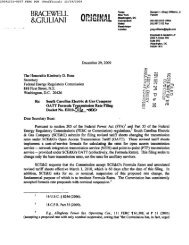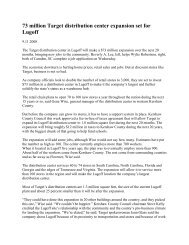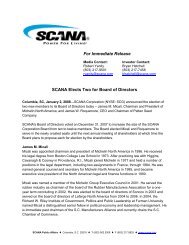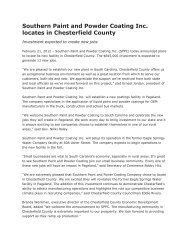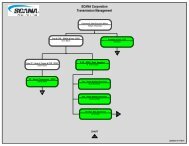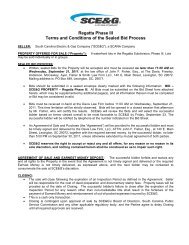10-K - SCANA Corporation
10-K - SCANA Corporation
10-K - SCANA Corporation
You also want an ePaper? Increase the reach of your titles
YUMPU automatically turns print PDFs into web optimized ePapers that Google loves.
Table of Contents<br />
8. EMPLOYEE BENEFIT PLANS AND EQUITY COMPENSATION PLAN<br />
Pension and Other Postretirement Benefit Plans<br />
SCE&G participates in <strong>SCANA</strong>’s noncontributory defined benefit pension plan, which covers substantially all regular, fulltime<br />
employees. <strong>SCANA</strong>’s policy has been to fund the plan to the extent permitted by applicable federal income tax regulations, as<br />
determined by an independent actuary.<br />
<strong>SCANA</strong>’s pension plan provides benefits under a cash balance formula for employees hired before January 1, 2000 who<br />
elected that option and for all employees hired on or after January 1, 2000. Under the cash balance formula, benefits accumulate as a<br />
result of compensation credits and interest credits. Employees hired before January 1, 2000 who elected to remain under the final<br />
average pay formula earn benefits based on years of credited service and the employee’s average annual base earnings received during<br />
the last three years of employment.<br />
In addition to pension benefits, SCE&G participates in <strong>SCANA</strong>’s unfunded postretirement health care and life insurance<br />
programs which provide benefits to certain active and retired employees. Retirees share in a portion of their medical care cost.<br />
<strong>SCANA</strong> provides life insurance benefits to retirees at no charge. The costs of postretirement benefits other than pensions are accrued<br />
during the years the employees render the services necessary to be eligible for these benefits.<br />
Changes in Benefit Obligations<br />
The measurement date used to determine pension and other postretirement benefit obligations is December 31. Data related<br />
to the changes in the projected benefit obligation for retirement benefits and the accumulated benefit obligation for other<br />
postretirement benefits are presented below.<br />
Other<br />
Postretirement<br />
Pension Benefits<br />
Benefits<br />
Millions of dollars 2011 20<strong>10</strong> 2011 20<strong>10</strong><br />
Benefit obligation, January 1 $ 687.8 $ 667.4 $ 171.5 $ 171.4<br />
Service cost 14.7 14.0 3.4 3.2<br />
Interest cost 37.0 41.2 9.6 9.3<br />
Plan participants’ contributions — — 2.5 2.4<br />
Actuarial (gain) loss 2.6 (0.6) 5.6 (1.1)<br />
Benefits paid (37.1) (34.2) (11.2) (11.4)<br />
Amounts funded to parent — — (3.0) (2.3)<br />
Benefit obligation, December 31 $ 705.0 $ 687.8 $ 178.4 $ 171.5<br />
The accumulated benefit obligation for retirement benefits was $666.7 million at the end of 2011 and $649.0 million at the<br />
end of 20<strong>10</strong>. The accumulated retirement benefit obligation differs from the projected retirement benefit obligation above in that it<br />
reflects no assumptions about future compensation levels.<br />
Significant assumptions used to determine the above benefit obligations are as follows:<br />
Annual discount rate used to determine benefit obligation<br />
Other<br />
Pension<br />
Postretirement<br />
2011<br />
5.25%<br />
Benefits<br />
Benefits<br />
20<strong>10</strong> 2011<br />
5.56% 5.35%<br />
20<strong>10</strong><br />
5.72%<br />
Assumed annual rate of future salary increases for projected benefit<br />
obligation 4.00% 4.00% 4.00% 4.00%<br />
An 8.2% annual rate of increase in the per capita cost of covered health care benefits was assumed for 2012. The rate was<br />
assumed to decrease gradually to 5.0% for 2020 and to remain at that level thereafter.<br />
A one percent increase in the assumed health care cost trend rate would increase the postretirement benefit obligation at<br />
December 31, 2011 by $1.4 million and at December 31, 20<strong>10</strong> by $1.4 million. A one percent decrease in the assumed health care cost<br />
trend rate would decrease the postretirement benefit obligation at December 31, 2011 by $1.2 million and at December 31, 20<strong>10</strong> by<br />
$1.3 million.<br />
129



